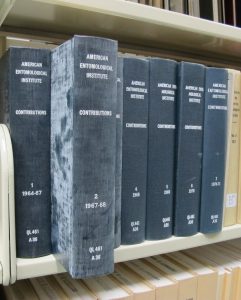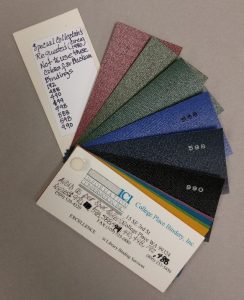
In 2012, a book truck of old serials with green buckram binding was brought to the University of Hawaii at Manoa (UHM) Library’s Preservation Department, where I work. Each of the volumes was covered in a white film that looked like mold or powdery mildew.
This didn’t make sense—the books had been in an area of the library considered very dry by Hawaii standards (relative humidity in the 40s and sometimes 50s) ever since a temperature and humidity data logger was deployed there in late 2008.
Mold is commonplace in Hawaii and is something UHM library has battled for years. So it was presumed that this was mildew that developed in years past and had gone undetected. Or that the books had been recently transferred from the non-climate-controlled library across campus without being cleaned.

But we searched for signs of this white film on the floor of the library and soon found many similar examples. If this was mildew, then why, in several cases, were only some books affected, especially large serial runs in the same binding that had presumably been stored together for decades?
A small team set out to find and clean all the affected books on that floor of the library. The usual mold procedure was followed using personal protective equipment: disposable respirator, gloves, and long sleeves. Each book was taken to a truck reserved for dirty books and vacuumed on all sides, after which the buckram was wiped with isopropyl alcohol to remove residue and help dry the surface before being transferred to a clean book truck for delivery back to the library stacks. Meanwhile, the empty metal shelf where the books had been was wiped with a disinfectant and allowed to air dry before the cleaned books were reshelved.
But over the next few years, the preservation department received more books with white film that required cleaning. Our investigation intensified in spring 2016. After we considered the location of the books and analyzed graphs from 36 data loggers situated throughout the three sections of the library’s many floors, we found one common denominator: There was low humidity on books that were bound more than 40 years ago but that had previously been stored in humid conditions. In fact, most—if not all—of these older books with white film had been in the campus’s open-air library, which had no heating, cooling, or dehumidification. Without environmental controls, insects and mold had ravaged many of them.
Toxins and treatment
In 1955, a local chemical company marketed two treatments to prevent damage by bookworms (Hawaii has an abundance of cigarette beetles and carpet beetles). One treatment was a “book insect repellent” with DDT, and the other was a “protective book lacquer” with the solvent xylene, both of which were developed by chemists and entomologists at the Hawaiian Sugar Planters’ Association. There is evidence that these formulas were used by UHM’s library many decades ago to fumigate its collections. Given this history, it became a priority to rule out residual contaminants from past toxic pest management treatments to ensure that staff and students were not being exposed to harmful materials.

We talked with the staff member who oversaw the UHM bindery services for many years and discovered that in the early 1980s the special collections department had identified specific grade F buckram colors that were thought to be predisposed to mold. This was an important clue, indicating a potential problem with book cloth in Hawaii’s climate.
The good news is that the Standard for Library Binding and formula for book cloth was changed around 1990, and in recent observations, no degradation of the coating on the book cloth has been noted for anything bound after the mid-1970s. The latest Library Binding Standard (ANSI/NISO/LBI Z39.78-2000) has been in place since 2000.
Our staff searched online and through journal articles for information on leather spue or spew, a dressing or other treatment leaching out of leather book covers or leather artifacts. Spue is sometimes described as “fatty” or “waxy.” Although this did not address the issues found with buckram binding, we thought that a similar reaction may be occurring between the book cloth and its coating when moved from high humidity to low humidity. With a lack of documentation, we contacted colleagues in California and Oregon to investigate whether this was a common phenomenon. Our two California contacts were not familiar with the problem; the Oregon contact had seen this in the past, but because the white film wipes off, affected books were simply cleaned and returned to the stacks without further analysis.
Lab work points to clues
When the white film was initially discovered, the library had only seven data loggers in use; by 2013, the library invested in 36 loggers, upgrading older units and providing coverage for every floor. By spring 2016, we had at least three years of temperature and humidity readings recorded for each floor of the library available for analysis.
Through a local contact, the preservation department had one of the affected books analyzed in a lab using Raman spectroscopy, a technique used to provide information on molecular vibrations and crystal structures. Results indicated the white film was organic (peaking for protein/lipids), but results were not definitive.

The researcher suggested that the powder looked like mold (which was the preservation department’s initial assumption). To rule out the possibility, a University of Hawaii mycologist scraped off a sample and put it in a solution on a glass slide, but it dissolved before he was able to observe it under a microscope. A dry sample from the same book confirmed the material was not fungus. The fact that the material dissolved in alcohol and was not identified as a fungus supported the hypothesis that the white flakes were a breakdown of book-cloth coating.
An emeritus professor of biology at University of Hawaii noted a similar problem he had encountered with the degradation of shell collections in museums. In response to a query posted on the American Library Association’s Association for Library Collections and Technical Services Preservation Administrators Interest Group, photograph conservator Gawain Weaver confirmed that a similar substance has been found on cellulose nitrate negatives (essentially nitrocellulose—a compound used in the manufacture of plastics and water-repellent coatings such as lacquers).
The best next step would be a controlled lab analysis. We had exhausted personal and professional contacts, so we reached out to a bindery vendor.
The vendor was not familiar with this phenomenon but suggested we inquire with the book-cloth manufacturer, Holliston LLC, which has been supplying binderies for more than 100 years. Its staff members were extremely helpful. They turned to a British commercial lab called Synthomer for FTIR (or Fourier-transform infrared spectroscopy) analysis, a method of infrared spectroscopy. The lab conducted a number of tests including comparing samples of common chemicals used in book coverings. Synthomer’s report stated that:
“Equipment and Measurement: The white powder was carefully scraped from the surface and transferred to a stainless-steel panel. Micro-FTIR was conducted using a Cary 620 microscope and Cary 660 FTIR.” Test results showed “the spectra of the white powder closely match sebacic acid. Sebacic acid in its natural state exists as powder crystal or white flake, which is consistent with observed material. Sebacic acid has a number of industrial uses, so source of contamination is not determined.”
A team effort
By consulting with professionals in libraries, the field of book conservation, and the natural sciences, the library was able to narrow down the cause of the white film and eliminate other possibilities. Lab testing and analysis did not provide definitive proof of the cause, but they pointed to the degradation of nitrocellulose as the culprit and identified the white film as sebacic acid.
The time and effort to solve this mystery was well worth confirming that the white film is not toxic. And the solution to the existing problem? In most cases, we can easily restore affected book covers with a lint-free cloth and isopropyl alcohol—something that should be bound for success.


